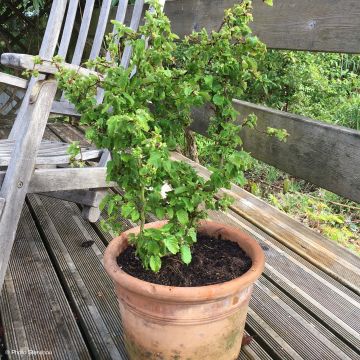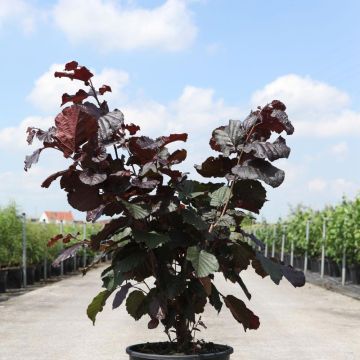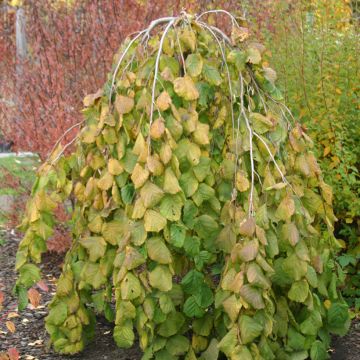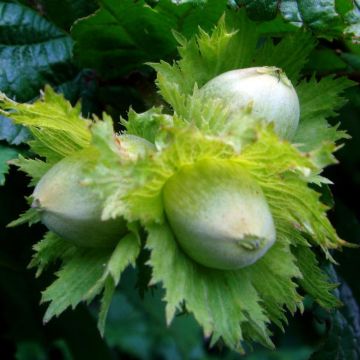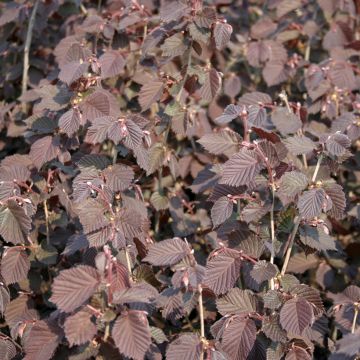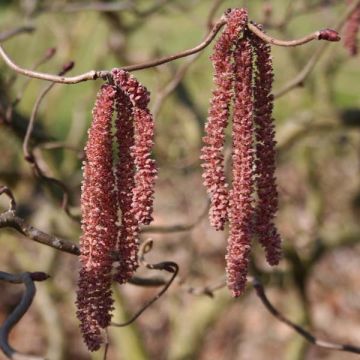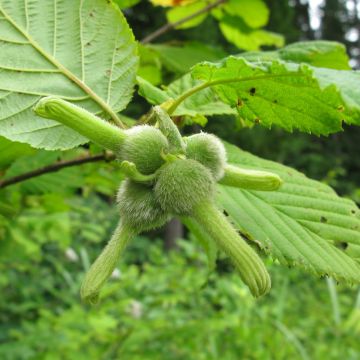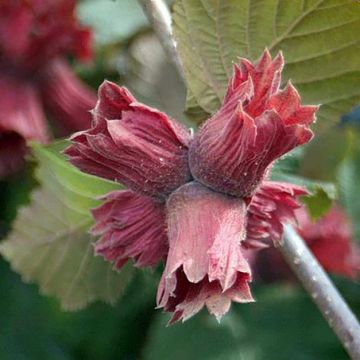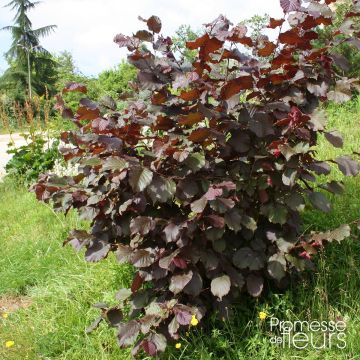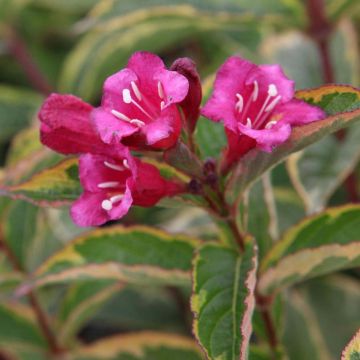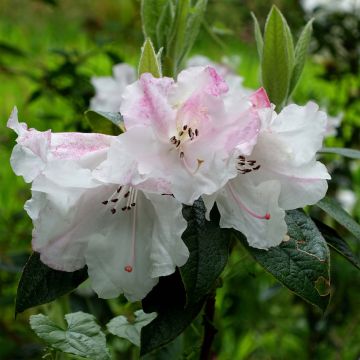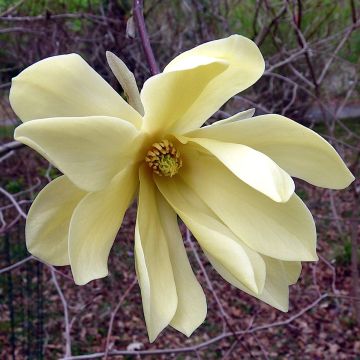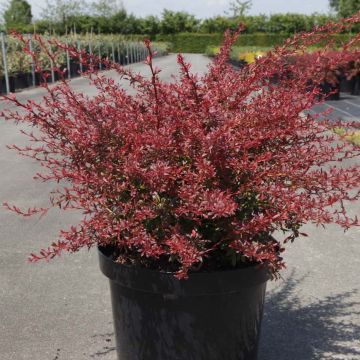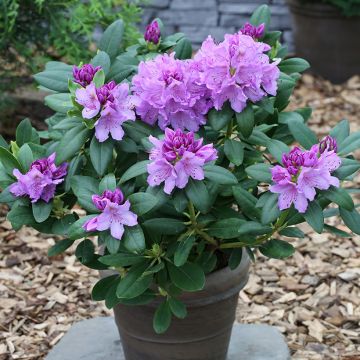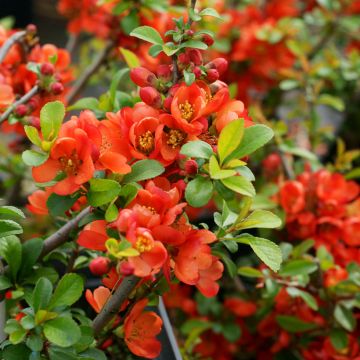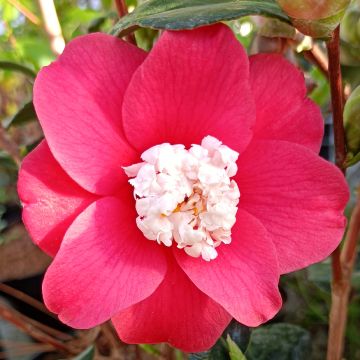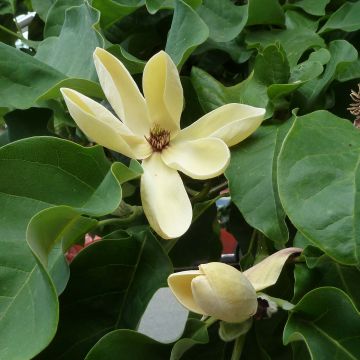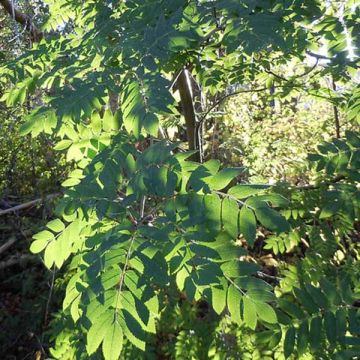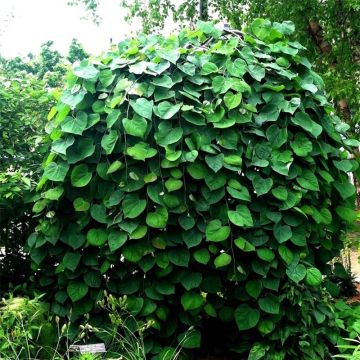

Corylus avellana Anny's Red Dwarf - Common hazel
Corylus avellana Anny's Red Dwarf - Common hazel
Corylus avellana Anny's Red Dwarf
Common hazel
This item cannot be shipped to the selected country
Delivery charge from €5.90
More information
Schedule delivery date,
and select date in basket
This plant carries a 24 months recovery warranty
More information
We guarantee the quality of our plants for a full growing cycle, and will replace at our expense any plant that fails to recover under normal climatic and planting conditions.
From €5.90 for pickup delivery and €6.90 for home delivery
Express home delivery from €8.90.
Does this plant fit my garden?
Set up your Plantfit profile →
Description
Corylus avellana 'Anny's Red Dwarf' is a small and remarkably colourful hazelnut bush, ideal for ornamenting small gardens and growing in pots. The foliage of this shrub changes from a beautiful dark red to violet and then to brownish green. The symphony of colours culminates in autumn, when the foliage turns violet again. Winter reveals branches adorned with small pendant pale mauve catkins covered in yellow pollen as spring approaches.
The 'Anny's Red Dwarf' hazelnut is a horticultural selection obtained in the Netherlands and introduced to the horticultural market in 1999. Like its ancestor Corylus avellana, the common hazelnut, this shrub belongs to the Betulaceae family. The species is native to temperate zones of the northern hemisphere, although it seems to be declining in the south due to climate change. It is a small monoecious fruit tree, bearing distinct male and female inflorescences on the same individual. The common hazelnut is a light-loving species that prefers neutral to slightly alkaline soil, is fairly fertile, and not too dry in summer.
Corylus avellana 'Anny's Red Dwarf' is a deciduous slow-growing shrub with an upright habit. It develops a short trunk topped with an oval and dense crown. Eventually, after many years, it will reach between 2.50 m and 3 m in height and 1 m to 1.50 m in spread. Its young hairy branches are dark purple, covered with light brown bark that becomes very dark over time. The very dense foliage appears late in May and gives the shrub its bushy appearance. The leaves are rounded, strongly veined, slightly crimped and curled, slightly glossy, smaller than those of most hazelnuts. The colour of the foliage changes over time. The young leaves are tinted dark red, gradually becoming purple, and the oldest leaves are brownish green in summer. Flowering of this cultivar is quite rare and always sparse when it occurs. In February-March, male flowers appear, gathered in pendant catkins 5 cm long, visited by bees. The foliage takes on beautiful dark colours before falling in autumn.
The 'Anny's Red Dwarf' hazelnut will attract all the attention in a small garden. Easy to grow in ordinary soil, it withstands cold weather perfectly. It is magnificent when planted as a specimen, and that's how it can be showcased. It could also be placed in the centre of a bed surrounded by 'Rozanne' hardy geraniums or pink heucheras such as 'Berry Smoothie', for example. One could imagine a small clematis with blue flowers 'Saphyra Indigo' spreading at the base of an already mature subject while climbing its branches. Growing in a large pot, on a terrace or balcony, is also possible. Also use its leafy branches in all your floral arrangements, with fragrant peonies, for example.
Report an error about the product description
Plant habit
Flowering
Foliage
Safety measures
Botanical data
Corylus
avellana
Anny's Red Dwarf
Betulaceae
Common hazel
Cultivar or hybrid
atteinterespiratoire
Cette plante peut entraîner des symptômes allergiques.
Evitez de la planter si vous ou vos proches souffrez de rhinite saisonnière ("rhume des foins").
Davantage d'informations sur https://plantes-risque.info
Other Corylus - Hazelnuts
Planting and care
Easy to grow and perfectly hardy, Corylus avellana Anny's Red Dwarf is well suited to most climates. It will adapt to any good garden soil that is not too dry, without excessive limestone or acidity. It appreciates a sunny to partially shaded location and will benefit from pruning. In late autumn, thin out the base by cutting back any troublesome branches.
Planting period
Intended location
Care
This item has not been reviewed yet - be the first to leave a review about it.
Spring-flowering shrubs
Haven't found what you were looking for?
Hardiness is the lowest winter temperature a plant can endure without suffering serious damage or even dying. However, hardiness is affected by location (a sheltered area, such as a patio), protection (winter cover) and soil type (hardiness is improved by well-drained soil).

Photo Sharing Terms & Conditions
In order to encourage gardeners to interact and share their experiences, Promesse de fleurs offers various media enabling content to be uploaded onto its Site - in particular via the ‘Photo sharing’ module.
The User agrees to refrain from:
- Posting any content that is illegal, prejudicial, insulting, racist, inciteful to hatred, revisionist, contrary to public decency, that infringes on privacy or on the privacy rights of third parties, in particular the publicity rights of persons and goods, intellectual property rights, or the right to privacy.
- Submitting content on behalf of a third party;
- Impersonate the identity of a third party and/or publish any personal information about a third party;
In general, the User undertakes to refrain from any unethical behaviour.
All Content (in particular text, comments, files, images, photos, videos, creative works, etc.), which may be subject to property or intellectual property rights, image or other private rights, shall remain the property of the User, subject to the limited rights granted by the terms of the licence granted by Promesse de fleurs as stated below. Users are at liberty to publish or not to publish such Content on the Site, notably via the ‘Photo Sharing’ facility, and accept that this Content shall be made public and freely accessible, notably on the Internet.
Users further acknowledge, undertake to have ,and guarantee that they hold all necessary rights and permissions to publish such material on the Site, in particular with regard to the legislation in force pertaining to any privacy, property, intellectual property, image, or contractual rights, or rights of any other nature. By publishing such Content on the Site, Users acknowledge accepting full liability as publishers of the Content within the meaning of the law, and grant Promesse de fleurs, free of charge, an inclusive, worldwide licence for the said Content for the entire duration of its publication, including all reproduction, representation, up/downloading, displaying, performing, transmission, and storage rights.
Users also grant permission for their name to be linked to the Content and accept that this link may not always be made available.
By engaging in posting material, Users consent to their Content becoming automatically accessible on the Internet, in particular on other sites and/or blogs and/or web pages of the Promesse de fleurs site, including in particular social pages and the Promesse de fleurs catalogue.
Users may secure the removal of entrusted content free of charge by issuing a simple request via our contact form.
The flowering period indicated on our website applies to countries and regions located in USDA zone 8 (France, the United Kingdom, Ireland, the Netherlands, etc.)
It will vary according to where you live:
- In zones 9 to 10 (Italy, Spain, Greece, etc.), flowering will occur about 2 to 4 weeks earlier.
- In zones 6 to 7 (Germany, Poland, Slovenia, and lower mountainous regions), flowering will be delayed by 2 to 3 weeks.
- In zone 5 (Central Europe, Scandinavia), blooming will be delayed by 3 to 5 weeks.
In temperate climates, pruning of spring-flowering shrubs (forsythia, spireas, etc.) should be done just after flowering.
Pruning of summer-flowering shrubs (Indian Lilac, Perovskia, etc.) can be done in winter or spring.
In cold regions as well as with frost-sensitive plants, avoid pruning too early when severe frosts may still occur.
The planting period indicated on our website applies to countries and regions located in USDA zone 8 (France, United Kingdom, Ireland, Netherlands).
It will vary according to where you live:
- In Mediterranean zones (Marseille, Madrid, Milan, etc.), autumn and winter are the best planting periods.
- In continental zones (Strasbourg, Munich, Vienna, etc.), delay planting by 2 to 3 weeks in spring and bring it forward by 2 to 4 weeks in autumn.
- In mountainous regions (the Alps, Pyrenees, Carpathians, etc.), it is best to plant in late spring (May-June) or late summer (August-September).
The harvesting period indicated on our website applies to countries and regions in USDA zone 8 (France, England, Ireland, the Netherlands).
In colder areas (Scandinavia, Poland, Austria...) fruit and vegetable harvests are likely to be delayed by 3-4 weeks.
In warmer areas (Italy, Spain, Greece, etc.), harvesting will probably take place earlier, depending on weather conditions.
The sowing periods indicated on our website apply to countries and regions within USDA Zone 8 (France, UK, Ireland, Netherlands).
In colder areas (Scandinavia, Poland, Austria...), delay any outdoor sowing by 3-4 weeks, or sow under glass.
In warmer climes (Italy, Spain, Greece, etc.), bring outdoor sowing forward by a few weeks.

































